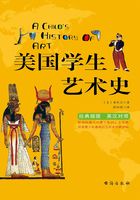
第9章 小小珍品
我曾经看到过一篇报道,其中介绍了为一座公共建筑而制作出来的一组雕塑。报纸上对这组雕塑的介绍,主要是说它重达十吨。报道并没有评价说这组雕塑究竟是丑是美,只是说它们重达十吨。没准儿是十吨煤炭呢。但是,仅凭尺寸可不会让一个东西美丽起来。古希腊人曾经制作出了一些巨型雕塑,并且都漂亮得很。他们还制作出了一些微型的雕塑作品;这些微雕的尺寸太小,人们只能用放大镜去看,才能看得出它们是多么精美呢。
有一次,我在博物馆里就看到了一件这样的雕塑作品。它的重量绝对不会超过一盎司,尺寸还没有一粒骰子大。那是一颗透光的五彩石子,上面雕刻了古希腊诸神的美丽形象,并且都是浅浮雕。诸神的形象都是用非常精细,但又非常锋利的工具,雕刻在石头上面。它是由某位古希腊雕塑家制作出来的,可如今却无人知道这位雕塑家姓甚名谁了。这件雕塑被称为“宝石”。如今,对于任何小而贵重的东西,我们都称之为宝石哩。
great as those who made life-size and colossal-size figures.These gems were made for kings and wealthy people, for no others could afford them.Rich people long ago used to collect such gems as you might collect stamps.Today museums-and those who can afford it-still do so.
Often these tiny bits of low-relief sculpture were cut in a stone that had two or three layers of different colors so that the figures were one color and the background another. If one layer was black and the other white, the stone was called onyx.If the top layer was reddish and those below it white and black, it was called sardonyx.Such sculptured low reliefs were known as cameos, and some were very beautiful.Today cameos are made of shells with two color layers and are called shell cameos.Some are cut from two or more layers of different-colored stone cemented together or from artificial sardonyx.
There was another kind of gem made in great quantities, in which the figures were hollowed out or sunken instead of being raised. A gem of this sort was called a seal or intaglio, which means sunken.The seals were used to stamp a design in wax.The stamped impression made from the sunken relief was raised in wax, and one could
伦敦的大英博物馆里有一整间藏室,里面全都是雕塑家们制作出来的这种宝石;而那些雕塑家,也与制作真人大小或者巨型塑像的雕塑家一样伟大。这些宝石都是替国王和有钱人制作的,因为其他人不可能买得起这样的东西。很久以前的有钱人经常收藏这样的宝石,就像你们如今集邮一样。而今天的博物馆,以及那些有经济实力的人,也还在这样做呢。

古罗马的石雕“奥古斯都之宝”,现存于维也纳的艺术史博物馆(由波士顿的大学印刷协会提供)
通常来说,这些微型的浅浮雕作品都是雕刻在一颗有两三层不同颜色的石头上,从而让雕刻出来的人物是一种颜色,背景又是另一种颜色。假如一层是黑色,另一层是白色,这样的石头就被称为“黑玛瑙”。假如最顶上的那一层是红色,而下面的一层是黑白相间的话,就叫作“缠丝玛瑙”。这样雕刻出来的浅浮雕,人们称之为“石雕”,其中有一些作品雕刻得非常精美。如今,石雕都是用有两层颜色的贝壳雕制而成的,因而被称为“贝雕”。有些石雕则是切下两层或者多层不同颜色的石子粘贴起来后再雕刻而成,或者是用人造缠丝玛瑙雕刻而成的。
还有一种大量雕刻的宝石,其中的图案都是镂空或者凹陷下去,而不是向上凸起的。这种宝石被称为“印章”或者“凹雕”;所谓的“凹雕”,就是凹陷下去的雕塑。这种印章,是用于在蜂蜡上压印出图案来。凹雕在蜂蜡上按压后形成的压
make as many stamped impressions with the seal as he or she liked.Each person who could afford it had such a seal with a special design all his own to stamp everything he wished to mark with his own hand.Everyone would then know he alone had made the impression.These seals are similar to the cylinder stamps that the Assyrians, who lived long before the Romans, used to sign their names.
Back in the days when few people knew how to write-or even how to sign their names-these seals were used to make marks that served the same purpose as signatures. Sometimes the seal was fitted into a finger ring that was worn by the owner so that no one else could use it.Such rings were called signet rings, or signing rings.Sometimes the seal was not mounted in a ring but was kept in a safe place so that no one but the owner could use it.
Have you ever collected coins?Many people do. Perhaps you would never think of such coins as a kind of sculpture, but that is what old coins are-pieces of low-relief sculpture.The Greeks used to make the most beautiful coins with heads or figures of famous people or gods on them in low relief.First they made a die that was a sunken relief, and then coins were stamped out of metal-gold, silver or bronze-with the die.
One difference between a coin and a gem is that a coin is made from a die and any number of the same coin can be made from one die. But a gem is one of a kind and cannot be duplicated.The coins of some countries today are really beautiful but not quite as beautiful as those the ancient Greeks made.One reason for this is that today our coins have to be made quite flat, or in very low relief, so that they will stack in a pile, for this
痕,是向上凸起的,而人们也可以用印章压出许多的图案来,想印多少就印多少。当时凡是买得起印章的人,都有一枚这样的印章,上面刻有属于自己的专用图案,可以亲手在想要打上标记的任何东西上盖下自己的印章。这样一来,大家便都明白,这个印记是他盖上的了。这些印章,与古亚述人的柱形印章类似;古亚述人所处的时期要比古罗马人早得多,当时他们常常是用柱形印章来签名的。
在还没有几个人会写字,或者说甚至没有几个人会签自己大名的古代,人们用这些印章盖印的作用,与如今的签名是一样的。有的时候,人们会把印章做成戒指戴在手上;这样一来,除了自己,别人就没法使用印章了。这种戒指,就叫“印戒”,也就是签名戒指。有的时候,人们不会将印章镶嵌在戒指上,而是会将其藏在安全的地方,因而除了印章的主人,任何人都别想使用这一印章了。
你们有没有收集过硬币呢?许多人都有这一爱好。或许,你们根本就没有想过,这些硬币也是一种雕塑呢;可古币事实上也是一种雕塑,是一种浅浮雕哩。古希腊人曾经制作出了最漂亮的钱币,上面用浅浮雕的方式雕刻有名人、神灵的头像或者全身像。他们首先会制作出一种凹浮雕模具,然后再用这种模具冲压出金属硬币来;而所用的金属,则是黄金、白银,或者青铜。
硬币与宝石之间的一大区别,便在于硬币是用模具冲压出来的,并且一个模具能够压制出大量的同一种硬币来。可宝石雕品却是独一无二、不可复制的。虽说如今一些国家里发行的硬币确实非常漂亮,可它们还是没有古希腊人制作的那样精美。之所以如此,原因之一便在于,如今我们的硬币必须制作得非常平整,或者说
is necessary in our banks.But it was not necessary to stack the old Greek coins in piles, so they could be made in higher relief.
Coins were, of course, used to buy things, but there were old coin-like sculptures called medals that generally were larger and were not used as money. The figures on medals were often in higher relief and were made by pouring the metal into a mold instead of by stamping the metal with a die.Usually such medals were made for prizes in athletic games, honors in war, or to celebrate some great event, anniversary, or celebration.Medals of this kind are still made today.Perhaps you know someone who has won such a medal and you can see for yourself.

雕有亚历山大大帝头像的古罗马勋章,现存于马里兰州巴尔的摩的沃尔特斯艺术博物馆
只能用非常浅的浅浮雕工艺,从而让它们可以叠放起来,因为银行需要这样。可古希腊人却不需将钱币堆叠起来,因而硬币上的图案可以制成较深的高浮雕。
钱币自然是用来买东西的,可还有一些样子很像古币的、叫作勋章的雕塑作品,它们虽说尺寸通常都比钱币要大,却不是用来当钱币使用的。勋章上的图案通常都是高浮雕,并且是将金属熔液倒入模具浇铸出来,而不是用模具冲压金属制成的。这种勋章,一般都是为了奖励运动会上的获胜者,表彰战争中的立功者,或者纪念某一重大事件、周年纪念或者庆典而制作出来的。人们如今仍然会制作这样的勋章呢。没准,你们认识的某个人曾经就获得过这样的勋章;那样的话,你们就可以亲自去看一看这种勋章了。